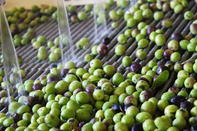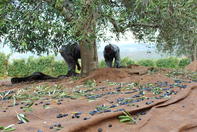Olive oil is produced from whole-pressed olives. Olive trees are naturally found around the Mediterranean area where the winters are mild and summers long, dry and warm.

Olives, however, can be grown anywhere with a frost-free climate, well-drained soil and irrigation or rainfall equalling, on average, 800 mm per year.
Olives are pressed within hours of harvesting, crushed and separated from solids and juice, before being bottled.
Harvesting of Olives

Olives can be harvested by hand or by machinery, Hand-harvesting, often associated with less damage to olives and better quality oil, contributes greatly to the production costs - in South Africa, up to 40% of the total cost.
The olive harvest in South Africa begins in late February or early March, with green table olives, and concludes in August, with the last of the late oil cultivars.
Table olives are hand-picked into containers and oil olives are stripped (or ‘milked’) onto nets on the ground under the trees.
The timing of the harvest can determine the colour, flavour profile of the final oil, its shelf life and health components. For certain olive varieties, low in natural polyphenol content, starting harvest a month late can decrease shelf live of the oil by four months. So, the desired end-qualities of the oil is determined by the harvest date.
Green (immature) olives impart a freshness, also perceived as a grassiness, and bitter notes to the final oil blend. Green olives are high in polyphenols (antioxidants) and other components, so oil made from unripe olives has a long shelf life, due to these natural preservatives.
Olives picked at veraison (colour change from green to red-purple) starts to render more fruity flavours. Oil is more yellow now and has fruitier and sweeter nuances. The oil yield of olives at the red-ripe stage is close to the maximum per dry weight.
As olives ripen, the skin changes from purple to black. These oils, from late harvest fruit, are golden in colour, less bitter, but can be easily damaged during harvest and have a shorter shelf live. The oil yield is high.
The best quality oil is made from olives at least matured to red-ripe stage.
How Olive Oil is Made

For the best quality oil to be made, olives should be pressed within 24 hours of harvest. After harvest, leaves and twigs are removed and olives are washed to clean them of pesticides, dust and other debris. Olives are then taken by conveyor belt to the mill, where they are then crushed to a paste. Malaxing of the paste for 20 - 45 minutes then follows.
Malaxing involves mixing the paste to allow for oil droplets to separate from the oil flesh and combine into larger drops. In the next step, oil is separated from the olive flesh and water by centrifugal force. Oil is then left in tanks to separate further in a process called ‘racking’. The oil may be filtered before bottling.
Other processes that may be necessary to improve the quality of oil include refining -to reduce acidity and improve the flavour, bleaching - to reduce chlorophyll, pesticides etc. and deodorisation.
Heating the olive pulp may increase the yield of the oil. However, for ‘cold extracted’ classification, no temperature higher than 28℃ during the extraction process is allowed.
The clean oils are then stored in stainless steel tanks kept at temperatures below 28℃ until bottling for a specific order. The quality of olive oil is retained much better in a tank than as a bottled product.
Oils from individual varieties will be tasted before being blended to ensure the desired flavour profile and shelf life.
Shelf-life of Olive Oil
Fresh oil has more health benefits. Over time, oxidation occurs, which causes the breakdown of beneficial compounds such as essential fatty acids.
Unopened olive oil has a shelf life of 18 - 24 months, but once opened, the oil must be used between 30 and 60 days. Store away from light and at room temperature to prevent oxidation. Storing in the fridge can lead to condensation inside the bottle; water adverse affects the oil quality.
By Marinda Louw